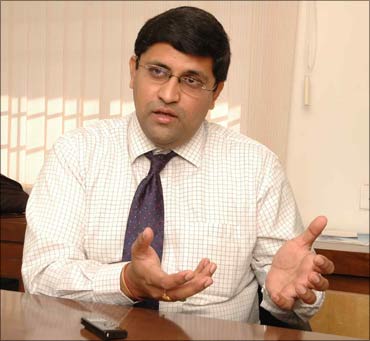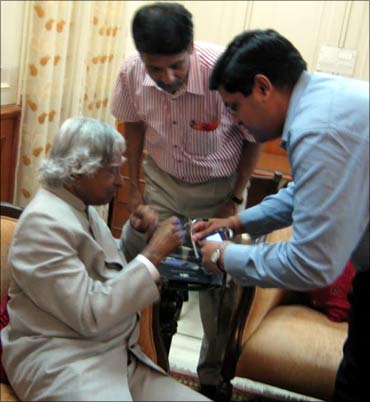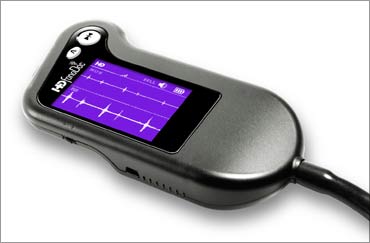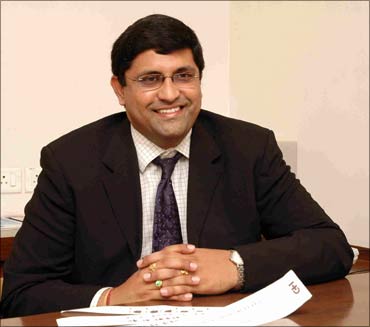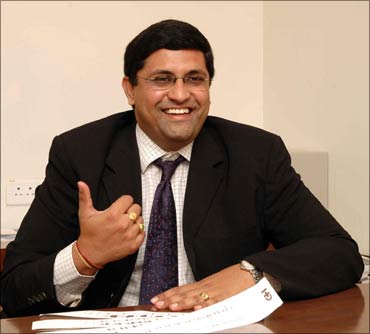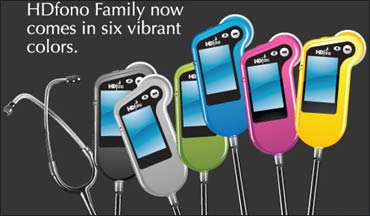 | « Back to article | Print this article |
Meet the Indian inventor who has 42 patents
In 2005, when Rediff.com met Arvind Thiagarajan, he was 25-year-old young inventor with a couple of patents to his credit. Today, he has more than 40 patents to his credit.
Interested in science and technology from when he was a child, the scientific temper in him got a boost with Dr A P J Abdul Kalam, the then scientific advisor to the Government of India, presenting him with the Junior Scientist Award in 2001.
From then on, Dr Kalam has been his mentor and advisor. It was the former President who urged him to invent and also patent his inventions.
The most trail blazing invention he has is HDFonoDoc, the first device of its kind in the world that can analyse and document heart murmurs in real time.
It is an audio visual auscultation device with an integrated murmur detector. He says HDFonoDoc can be used as a replacement to the mechanical and digital stethoscopes used by doctors worldwide.
Today, Arvind Thiagarajan is the chairman and chief inventor for two companies -- MatrixView and HD Medical Services (India) Pvt Ltd. Both the companies have offices in India, the United States and Australia.
In this interview, Arvind Thiagarajan talks about the most successful products he has invented and also the need for youngsters to invent and patent.
Click NEXT to read on . . .
Meet the Indian inventor who has 42 patents
You said when we met five years ago that innovation was a hobby for you. For such a person, you have more than 40 patents now. What is innovation to you now?
Innovation is very important for transforming new business avenues. There are many existing technologies available but if you want to do something differently, innovation is very critical.
To quote my mentor Dr Abdul Kalam, 'Innovation is the key to national economic growth.' He says India ranks only 40th in the innovation index and it has to come within the top 10 to achieve excellent growth.
Innovation can force more economic growth and create more job opportunities. It is innovation that took American companies to a different league.
When did you become aware of patenting ideas?
I was not even aware of what patenting was when I was in college. It was Dr Kalam who opened my eyes to the importance of patenting. He told us that whatever ideas we had, we must patent. It was like fencing a plot of land you have and protecting it from unwanted elements.
Click NEXT to read on . . .
Meet the Indian inventor who has 42 patents
Who guided you when you first filed for a patent?
Back in 2001, when I was passing out from the Guindy Engineering College, Dr Kalam spent a year at the Anna University campus. That was before he became the President.
He had organised a lot of patent awareness sessions at the university where he had invited people from the Indian Patent Office, apart from other experts. They spoke on how to write the patent application, how to write claims and how to file.
That was the first time all of us were exposed to the very idea of patenting. If you are applying to MIT, Boston, in the application form, they ask you, how many patents and how many publications the applicant has. It is not so here. But I was fortunate to have direct guidance from Dr Kalam.
Recently when I met him, he was very happy that I followed his words diligently.
How do you go about inventing and patenting ideas?
Once you have an idea, and you crystallised it into a form, you can file for a provisional patent. You require only Rs 1,000 to do that.
After that, you have one year to file for a complete patent with all the details and what all you want to protect. Then, there is the Patent Cooperation Treaty through which you can file for an international patent; you need not go to every country and file for a patent.
Click NEXT to read on . . .
Meet the Indian inventor who has 42 patents
Today, do you guide youngsters on innovation and patenting?
Yes, I do. I have been informally guiding a lot of youngsters in the last two years. Now, after meeting Dr Kalam recently, I am inspired to do it in a more structured and formal manner.
I plan to start a forum, a non-profit foundation which will give mentoring on patenting. It will mostly be online.
We plan to name it SAIENCE Foundation (Societal Advancement by Innovation, Entrepreneurship, Nurturing, Collaboration and Execution).
I am talking to some of the retired patent controllers of India who gave very good advice to me in the past. I plan to form the core group with retired experts and also those who work currently.
Then, we plan to go to IITs, IIMs, IISC, the Anna University, et cetera and talk to the students. If there are good ideas, we plan to do the mentoring. If they are serious about going ahead with the ideas, we will provide them with incubation facilities.
Click NEXT to read on . . .
Meet the Indian inventor who has 42 patents
SAIENCE Foundation plans to work with Dr Kalam's Vision 2020 Action Group to empower rural India through tele-medicine, tele-education and e-governance in all the PURA (Providing Urban amenities in Rural Areas) villages.
This will encourage a lot of youngsters to come up with ideas for the society and the country.
For the last two years, we have been conducting an event called Technovator at Anna University. We give a lakh of rupees (Rs 100,000) to the top two ideas so that they can start developing the prototype and pursue the idea.
What are the things a budding innovator has to be aware of?
There are three aspects to innovation. One is filing the patent. Filing the patent is like buying a property and fencing it.
Next is incubation. In the US what they really mean by incubation is providing guidance on what is unique about the idea, what problem it is trying to solve, which market space it will fit into, the size of the market, how to develop the product and position it in the market, and finally create a proper business model.
Click NEXT to read on . . .
Meet the Indian inventor who has 42 patents
Once you get the business model right, you need to commercialise the venture. You need to have investment for that whether it is from venture capitalists or funds.
These three aspects -- innovation, incubation and investment -- go together.
In your case, how did you incubate your first idea and from where did the investment come?
When I developed my first idea, I was 21. I had a job offer then but the joining time was delayed by six months. I decided to follow Dr Kalam's advice and patented the heart card I invented then.
The Singapore government was setting up an incubation centre in India. My patent came to their notice and they showed interest in incubating the technology and offered me $1 million.
They invited me to go to Singapore and set up a company. It was a very good experience. I was really fortunate to get funding from the Singapore government.
In 2003-04, when they came out of the incubation programme, I bought back the patent. By then, the technology was proven, so I got some venture capital investors.
By then again, I had my second innovation on lossless image compression. A Korean family and an investor from Australia wanted to invest in the idea. The company was listed on the Australian Stock Exchange also. That was Matrix View.
Click NEXT to read on . . .
Meet the Indian inventor who has 42 patents
When you started, your two major products were image compression and the heart card. How have they shaped by now?
When we met in 2005, we had only one company, Matrix View. We started HD Medical Services (India) Pvt Ltd later in 2005. In the first two years, we developed a product called Visual Stethoscope or Viscope.
It was a stethoscope with a visual display. BPL was our distributor. It was well received as a technology. The feedback we got from doctors was about analysing the waves. They felt it would be better if they could take a printout of the analysis.
Based on the feedback, we started developing our new product in 2009. In 2010, we came out with HdFonoDoc.
This product analyses and comes out with an interpretation on whether there is murmur in the heart or not, to help the early detection of cardiovascular diseases. When connected to the printer, you can take a printout too.
Click NEXT to read on . . .
Meet the Indian inventor who has 42 patents
Have you validated the product clinically?
Yes, we validated the product clinically at Sai Baba Hospitals in Bengaluru and Puttaparthi. We then approached the Union health ministry and they recommended us to go officially to DGHS (Directorate General of Health Services) who in turn commissioned two validation studies.
One was at JIPMER, Puducherry under Dr Balchander, HoD, Cardiology. He did a detailed evaluation comparing it with ECHO (echocardiogram) and found that it showed 95 per cent accuracy when compared to ECHO.
What is the difference between ECHO and HdFonoDoc?
There are three basic tools cardiologists use. One is the stethoscope, the ECG for the electrical aspects, and the ECHO for the mechanical aspects of the heart. ECHO costs lakhs of rupees.
HdFonoDoc lies between a stethoscope and ECHO, more like a low end ECHO. We called it FonoDoc because it can document the sound and murmurs of the heart that are not detected by ECG.
This is positioned for GPs (General Practitioners) and for rural clinics where specialists are not available. In India, there are 600,000 doctors and out of which 80 per cent are GPs.
We are getting excellent response from GPs as this is a better tool. We have sold 300 units in 3 months. We launched it in November 2010 and it is priced at Rs 40,000 in the Indian market.
Another product from HD Medical is a teaching tool which is a modification of HdFonoDoc, and we have named it HDGuruDoc.
Click NEXT to read on . . .
Meet the Indian inventor who has 42 patents
How far have you taken Matrix, the lossless image compression product?
A lot. When a file is compressed, it needs less storage space and also its transmission is faster. We found that storage is not a problem for anyone today but everyone requires faster lossless transmission.
A lot of clinics in NHS cluster in the United Kingdom have an in-house reporting radiologist, and what the clinics do is they copy the images onto a CD and courier it to the radiologist.
What we do is, we provide them with an online solution. More than 300 institutions of NHS are using this in the UK. We sell it under the name CIMAR Solutions in the UK as a joint venture. That is the first market we have captured.
In Singapore also, we work with a group which supply to seven neighbouring countries including China.
In Italy, we are selling it as the software (MVIstream).
In India, we work in 90 centres. We are probably the second largest player in the Asia Pacific market.
Once we get the FDA approval, we will go to the US market too. I spent two years in the US learning the imaging market in the US.
Click NEXT to read on . . .
Meet the Indian inventor who has 42 patents
Have you decided to concentrate on the two major products of yours, HdFonoDoc and MatrixView?
Yes. Though I have many patents and ideas, I want to concentrate on and execute these two ideas.
One of our investors, Steve Killelea of Integrated Research -- who has invested $5 million in HD Medical Services -- said it is easy to get ideas but to execute each idea, it takes ten years.
That is exactly what happened to me. It has been ten years since I started to execute these two ideas. Having a product company is a big challenge in India as it is services that dominate in India.
Even in the first month itself, they can achieve profits and cash flow positive but it will take much longer -- 3 to 5 years -- for a product company like ours.
We plan to concentrate on healthcare, defence and Internet hereafter. MatrixView with five products has generated $5 million as revenue. HD Medical Services with an investment of $10 million, has Rs 1 crore (Rs 10 million) revenue every year for the last three years.
Things are much better in India now compared to what it was when I started out 10 years ago.
A lot of Indians are coming back and becoming entrepreneurs. That is a very good sign.
